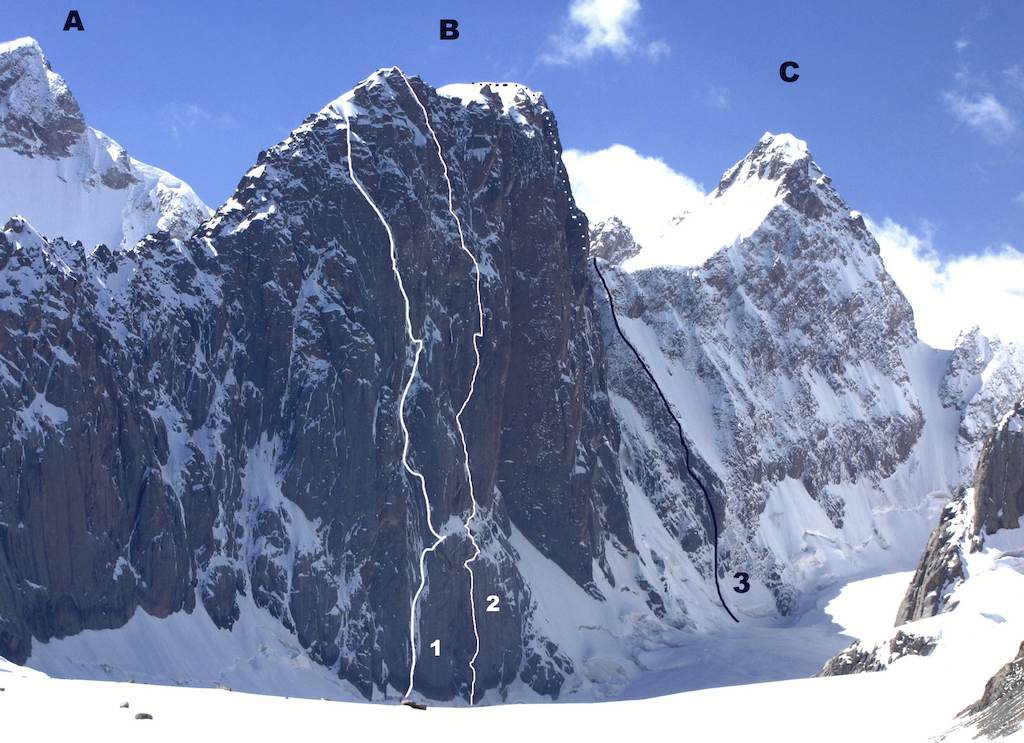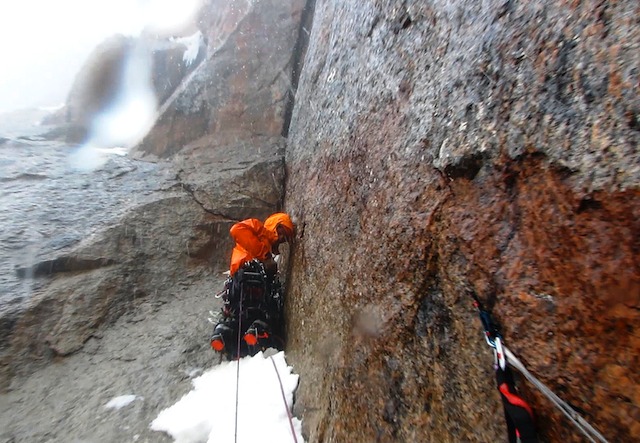Pik Vernyi (ca 5,250m), Northwest Face, No Shachlik
Asia, Kyrgyzstan, Tien Shan, Western Kokshaal-Too

In July Julien Christe, Alexandre Gal, Jérôme Gottofrey, and I headed for Kyrgyzstan to attempt the northwest face of Pik Vernyi above the Kyzyl Asker Glacier. We had climbed in this region during 2004 and seen the face, but we didn’t have the equipment to make an attempt. This 700m wall of vertical, compact granite, split by few cracks and characterized by enormous tafoni (cave-like features in the rock formed by wind, or salt erosion), has been attempted around seven times since the early 1980s but was not climbed until 2009, when Nikolai Bandalet’s five-man team spent four days climbing a line close to the left edge (AAJ 2010).
We reached the area in an old Soviet vehicle. Though not inspiring on first acquaintance, it proved remarkably efficient. To access base camp we had to drive 15km across a marshy delta. We bogged down four times and had to use jacks to lift the wheels, then put boards and stones on the ground to start moving. We were lucky that our driver, Sasha, was bold and experienced. Two days later we reached base camp, exhausted. A French team, which also planned to operate from this valley, never made it, the driver being less adventurous.
After establishing an advanced camp at the foot of the face, we watched a meteorological parade. A night of bad weather plastered the face with snow, making it impossible to climb. Spindrift and sloughing snow cascaded down the face that day after the storm, and it was another day before fine weather returned, melting the snow and soaking the rock. We realized that we shouldn’t fret but instead make progress, whatever the conditions. Our beautiful dream of free climbing had to be forgotten; we were forced into an aided ascent.
The wall can be divided into three parts: first a sort of compact shield with thin cracks; second the main section of wall, which features large crack systems; and finally a section of ice. Progress was slow, but after five days we’d climbed the initial buttress. Then it was time to haul the portaledges to the top of pitch six and set off in capsule style.
The first night the ledges proved uncomfortable; we were not well protected from the snow and ice that drummed on the fabric of our precarious habitat. Shelling the next day was intense, and we found it impossible to go out. Eventually, we were able to start moving, only to find the cracks chocked with ice. Wet snow on the rock didn’t help either, making the climbing more difficult and progress even slower.
We placed our second camp in one of nature’s peculiarities: an enormous tafone, large enough to give complete shelter, at the top of pitch 13. In fact the cave was formed by a large flake, completely separated from the rock. There was a drop of 600m below our feet and a long arch over our heads. The ground above proved the most trying on the nerves. A large snowpatch, 200m above, was melting. It was the start of the summer season, and the cold temperatures predicted by the Russians were now beginning to rise uncomfortably. Streams turned into torrents down the wall. We became soaked to the skin, and while one pair was climbing, the other was drying shoes, jackets, and outerwear over three gas stoves, which burned non-stop inside our ledges. Morale was low, but over the next two days we managed to make it to the snowpatch.
The final pitches leading to the top were mixed, and we were able to climb faster. On the summit, in the slanting rays of the setting sun, we were euphoric, and celebrated by clinking glasses of smuggled brandy, carried up the route for this occasion. Below our feet lay 900m of climbing and the new route No Shachlik (No Barbeque in Russian, 23 pitches, VI 6c A3 M6).
Maria Gal, Switzerland




